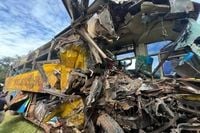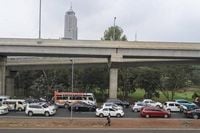In the early hours of Wednesday, October 22, 2025, tragedy struck along Uganda’s Kampala-Gulu highway near Kitaleba Village in Kiryandongo District. What began as a routine night for travelers ended in devastation when a multi-vehicle collision claimed at least 46 lives and left several more injured, according to police reports cited by Anadolu Agency, Xinhua, and The Associated Press. The accident, involving two passenger buses, a lorry, and a smaller car or SUV, is being described as one of the most serious traffic disasters in recent Ugandan history.
The crash occurred just after midnight, around 12:15 a.m. local time. Police initially reported a staggering death toll of 63, but later revised the number downward as several victims thought dead were discovered unconscious and alive in local hospitals. The confusion and chaos at the scene only added to the heartbreak for families awaiting news of their loved ones.
According to preliminary investigations, the disaster unfolded when a bus traveling from Kampala to Gulu attempted to overtake a lorry. In that moment, it collided head-on with another bus coming from the opposite direction. The impact triggered a chain reaction, causing multiple vehicles to overturn and resulting in a scene of twisted metal and shattered glass. “In the process, both buses met head-on during the overtaking maneuvers,” police stated, as reported by The Associated Press. The aftermath was grim: bodies strewn across the roadway, with survivors suffering from broken limbs and severe bleeding.
Red Cross spokeswoman Irene Nakasiita painted a harrowing picture of the scene. “The magnitude of this incident is so big,” she said, emphasizing the severity of the injuries and the emotional toll on first responders. She noted that, unlike accidents during daylight hours, nighttime crashes often lack the immediate assistance of bystanders, making rescue efforts even more challenging.
Most of the injured were rushed to a nearby government hospital, with the most critical cases referred to Mulago National Referral Hospital in Kampala. The Uganda Red Cross Society quickly deployed additional ambulances and emergency teams to transfer patients for specialized care. “While much of the attention has rightfully focused on the number of lives lost, it is equally important to spotlight the survivors who are critically injured and still fighting for their lives,” the Red Cross said in a statement.
The government’s response was swift. Ugandan President Yoweri Museveni expressed his condolences in a message posted to his X account: “I have learnt with sadness about the tragic accident that occurred this morning along the Kampala-Gulu highway, claiming many lives. I extend my condolences to the bereaved families and wish the injured a quick recovery.” In a gesture of support, Museveni announced that each bereaved family would receive five million Ugandan shillings (about $1,440 USD), while the injured would receive one million shillings in assistance.
The Ministry of Works and Transport dispatched a special team to aid police investigations and urged all motorists to avoid dangerous overtaking, promising a comprehensive report on the “devastating crash.” Authorities have also coordinated closely with medical and emergency teams to ensure accurate updates as the investigation continues. Police extended their condolences to victims’ families and called for greater caution on Uganda’s roads, noting that the incident stands out as one of the most severe in recent memory.
This disaster has reignited urgent concerns about road safety in Uganda and across East Africa. Fatal road crashes are, unfortunately, a common occurrence in the region, where roads are often narrow and infrastructure can be lacking. Official police figures reveal a troubling upward trend: 5,144 people were killed in road crashes in Uganda in 2024, up from 4,806 in 2023 and 4,534 in 2022. The 2024 Annual Crime Report recorded 25,808 casualties from road crashes, compared to 24,728 the previous year.
Careless overtaking and speeding are major contributing factors, accounting for nearly half—44.5%—of all crashes documented in 2024. Despite periodic safety crackdowns, including the suspension of bus operators after repeated accidents, fatal crashes remain all too frequent on Uganda’s highways. The Ministry of Works and Transport, in the wake of this latest tragedy, has reiterated its commitment to improving road safety and enforcing regulations, but the challenge remains daunting.
For road safety campaigners like Joseph Beyanga, known as Joe Walker, the crash in Kiryandongo is a painful reminder of the long road ahead. “These crashes are just a cruel reminder that we still have a long way to go,” Beyanga told The Associated Press. “On the government side, there is total absence of enforcement. What’s happening on the roads is anarchy.” Beyanga, who organizes regular walks from Kampala into the countryside attended by hundreds of followers, has announced a memorial walk of more than 37 miles in November to honor the memory of the countless people killed or maimed in road crashes over the years.
Experts and activists point to several root causes: reckless driving, especially by heavy vehicles at night; poor road infrastructure; and a lack of stringent enforcement of traffic rules. In many cases, police blame speeding and overtaking for the carnage, but advocates argue that deeper systemic issues must be addressed if real progress is to be made.
Meanwhile, the families of those lost in the Kiryandongo crash are left to mourn. The government’s financial assistance offers some relief, but the pain and trauma linger. For survivors, the road to recovery will be long and arduous, both physically and emotionally. As the country grapples with the aftermath, the hope is that this tragedy will serve as a wake-up call—prompting not just condolences and promises, but lasting action to make Uganda’s roads safer for everyone.
In the shadow of this devastating accident, Uganda faces a crossroads. The challenge is clear: to translate the lessons of loss into meaningful reforms that protect lives and restore confidence in the nation’s highways. Only time will tell whether this moment of grief can spark the change so desperately needed.






